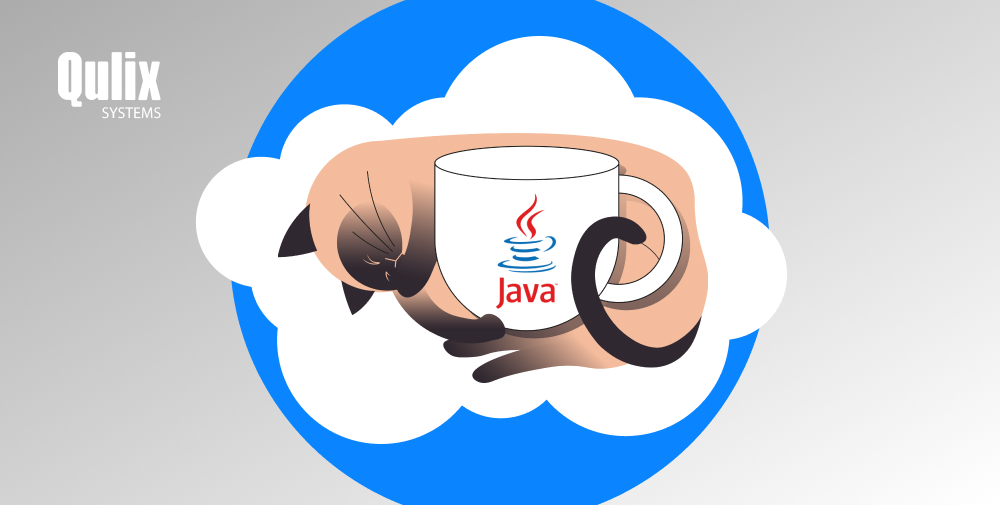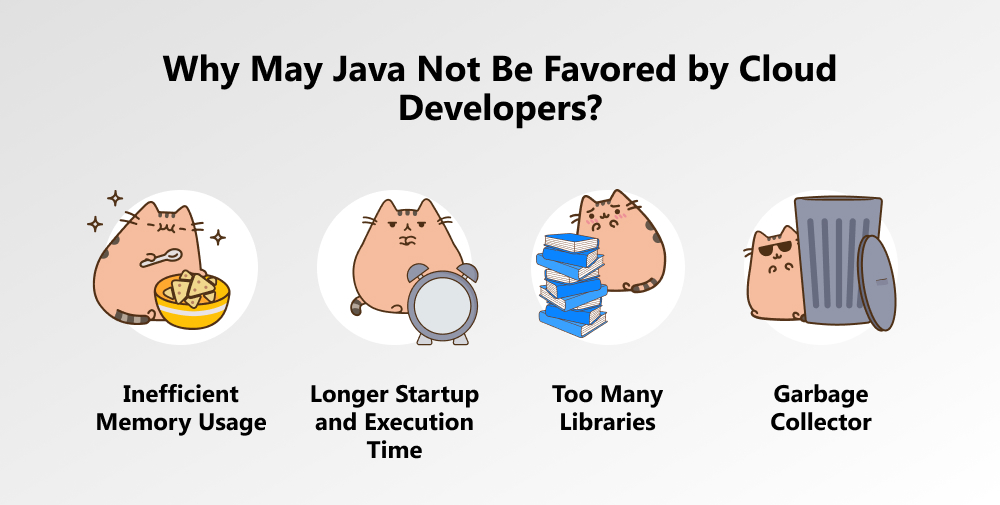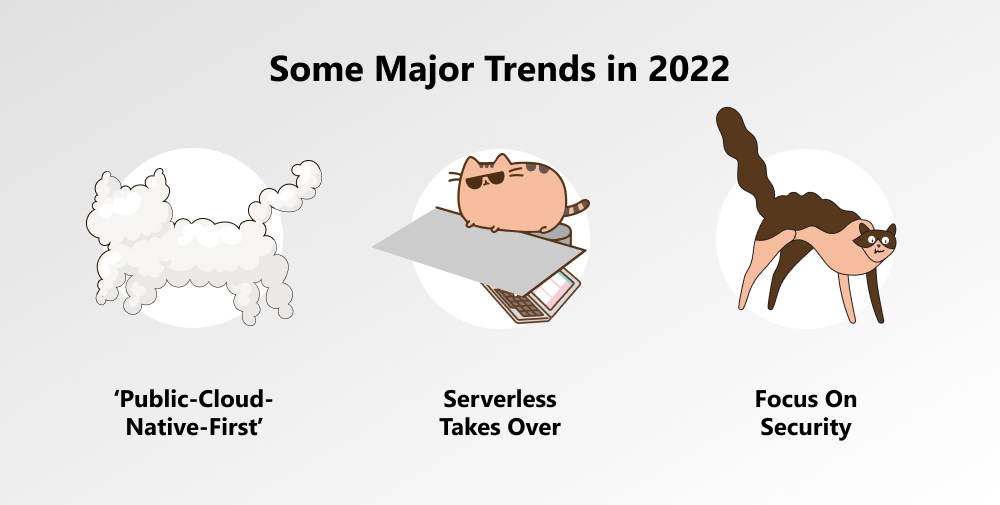Over the past few years, the popularity of cloud-native technologies has been rapidly increasing due to their high flexibility and adaptability to business needs. This advancement helps build better software faster and stay well ahead of competitors. So, let’s have a look at the latest сloud-native Java trends and discuss what to expect in 2022.

written by:
Aliaksandra Tsikhanovich
Over the past few years, the popularity of cloud-native technologies has been rapidly increasing due to their high flexibility and adaptability to business needs. This advancement helps build better software faster and stay well ahead of competitors. So, let’s have a look at the latest сloud-native Java trends and discuss what to expect in 2022.
Contents
Java Transformation
It has become especially visible when businesses leaned heavily on cloud solutions during the pandemic, which as a result, caused rapid revenue growth for organizations like Google Cloud, Alibaba, Amazon Web Services, and Microsoft Azure. In turn, the increasing importance of cloud-native paradigms requires a new vision for Java software development in order to keep one of the most popular programming languages on a competitive edge and stay well.
Faster and lighter runtime, efficient development, reduced complexity, and system stability are a few of the many reasons cloud-native software architecture is gaining popularity and is predicted to spike even more in 2022. It suggests that each component of the architecture can afford to fail without damaging the whole system and, then, self-recover. It provides the distributed application architecture with elasticity and resilience while allowing businesses to adapt easily to their ever-changing needs. According to the survey conducted by Lightbend last year, more than 59% of respondents already run most of their new applications in Kubernetes, the standard open-source container orchestration platform maintained by the Cloud Native Computing Foundation.
Meanwhile, the Java language with its consistency, reliability, scalability, and rich ecosystem manages to be one of the most popular programming languages even over two decades after its creation. In fact, no other language has been so popular for so long. According to IDC analyst firm, 90% of Fortune 500 companies rely on Java. This dominance on the market calls for further adoption of the latest technologies, especially cloud-native software development. However, the question arises, whether Java is still managing to keep up with the latest trends and able to provide modern developers with all the necessary to build cloud-native applications.
Java’s Position in the Cloud Native Java Era
While Java is most developers’ top choice in the enterprise software field, unfortunately, it is not the most preferred language when it comes to cloud-native development. In this new world of containers, Java’s strongest sides become its weaknesses and it is continuously challenged by more agile and flexible languages like Python and Golang.
Inefficient Memory Usage
During its startup, the Java Virtual Machine (JVM) is converting bytecode into native code through the Just-In-Time compiler, which leads to high consumption of memory and CPU resources. While this is an unnecessary feature for the cloud-native environment, it also prevents developers from using server capacity to its fullest.
Longer Startup and Execution Time
Optimizing bytecode not only consumes more memory but also adds extra time to the overall execution, making it longer if compared to other languages. Moreover, for microservice-oriented applications that require fast iteration, Java’s startup is too long, causing a great deal of time being wasted during the development process and defective user experience due to access latency.
Too Many Libraries
Containerized Java applications require additional libraries to communicate efficiently. While having many libraries is good for solving more complex problems, for a microservice architecture, instead, it increases the size, slowing down the startup time and making cloud-native Java applications less agile.
In order to succeed in cloud-native development, the language has to be reactive, with an extremely low memory footprint and quick startup time. While traditionally Java does not seem to be well-equipped for it, it has become one of the main priorities of Java developers to modernize it, while not losing language’s main benefits.
Garbage Collector
Basically, you have no control over garbage collection in the case of Java. It does not provide programmers with the functions like delete(), free(). So it can be an advantage or disadvantage depending on your coding practice and application under development.
So, how is Java going to remain relevant in the cloud-native era?
Frameworks Are Java’s Future
Next-generation frameworks are predicted to become Java’s new identity, as they are created exactly to address Java’s shortcomings when it comes to cloud-native development. More promising options such as Quarkus and Micronaut are customized to be cloud-native and already demonstrate much shorter booting time and resource costs. It allows millions of Java developers to avoid learning an entirely new language. Moreover, considering how young both frameworks are and the speed at which the open-source community can solve issues, there is a high chance that Java will keep its dominating place in the cloud-native era as well.
Before we have a look at the two most promising Java frameworks, it is important to mention another relatively-new product without which cloud-native Java would not stand a chance. GraalVM is a universal virtual machine released by Oracle in 2019 that supports multiple languages and allows to compile programs ahead of time into a native executable. Compared to classic Java VM, GraalVM gives an advantage of lower booting time (significantly faster than the OpenJDK implementations) and runtime memory cost. Together with frameworks, it can truly let Java flourish in the cloud-native age.
Quarkus
Quarkus is an open-source Java framework initiated by Red Hat, the main purpose of which is to make Java more competitive in the cloud-native environment. Quarkus is Kubernetes-native, putting forward the "container first" concept, while it also uses GraalVM to compile Java code into native-ready. It helps to reduce execution costs while increasing productivity. Let's have a closer look at its main advantages:
1. Imperative and Reactive Programming Brought Together
Quarkus framework supports classic imperative programming approach, while also following non-blocking reactive programming method. It means applications can be supported in both languages and developers can take advantage of a more relevant reactive style, whilst still working with Java standards and popular libraries such as Eclipse MicroProfile, RESTEasy (JAX-RS), Hibernate ORM (JPA), and others.
2. Efficiency
Statistics by Quarkus.io provide a clear picture of increased efficiency. In combination with GraalVM, Quarkus’ startup time is being reduced by almost 99% — down to 0.055 seconds (compared to 9.5 seconds required by the traditional service stack). Furthermore, high-density memory utilization led to only 35 MB of memory necessary, which is around 86% less than required by traditional Java applications. Increased efficiency, in turn, also leads to cost reductions and Java being highly compatible with cloud-native development.
3. Live Coding
Another efficient feature of Quarkus is live coding, meaning live reload in the blink of an eye without using third-party plugins. The result of every change is visible immediately to the developers, saving them time and supporting an efficient development environment.
As a result, Quarkus enables Java to solve the drawbacks that have been holding it in the past, while giving it the opportunity for further development and innovation. Meanwhile, as the framework is quite immature, there is a lot of space for improvements that can be awaited in the future. However, Quarkus is moving ahead quite fast, so let us wait and see how its evolution unfolds.
Micronaut
Micronaut is the second promising full-stack Java framework. It has been introduced by the creators of the Grails Framework in 2018, making it slightly older than Quarkus. Same as Quarkus, it aims to provide faster startup and to reduce memory footprint through building around GraalVM, supports reactive programming, and is predicted to define the future of Java microservice and serverless applications. Micronaut uses features like JVM-supported hot-loading and RefreshEvent, which play a similar role to Quarkus’ live coding, letting the development cycle to be quick and efficient. Meanwhile, unlike Quarkus reliant on Eclipse MicroProfile APIs, the Micronaut framework defines its own APIs, making it easy to write new integrations.
Furthermore, Aspect-Oriented Programming (AOP), which does not use reflection to define cross-cutting concerns, and compile-time dependency injection, which is exactly the reason for significantly shorter application boot time, both make Micronaut especially suitable for serverless development.
Other Major Trends to Watch Out For in 2022
According to Lightbend, “75% of respondents already host the majority of their applications in some sort of cloud infrastructure; more than 60% are using microservices in production”. And the cloud-native industry is predicted to grow even more in 2022. So, what would be the main trends evolving next year?
1. Public Cloud Native
According to the Forrester report on upcoming business and technology trends, it is predicted that post-pandemic time will call for the “public-cloud-native-first” strategy. They say global public cloud infrastructure will spike by 35% and 60% of the companies will implement this strategy within the next two years.
The importance of the cloud has become especially visible, as companies turned to it during the pandemic in order to provide their employees with all necessary tools in a quick manner and at a low cost. Meanwhile, migration to the cloud is expected to become a trend among companies in order to facilitate the implementation of the fast-evolving cloud-native technology, while maximizing cloud capabilities and focusing on business development. Java’s focus on cloud-native development is especially important to stay on top of this trend.
It is expected though that there will be challenges in cloud adoption and that the governments will eventually need to come up with regulations on how and when companies can use the cloud. It is also expected that once cloud traditional advantages reach their extent, the only way to compete will be through innovation.
2. Serverless Takes Over
In recent years, the focus of cloud-native technology has been mostly on containers, their orchestration, and microservice architecture. However, in 2020, serverless has slowly taken over as one of the top fastest-growing PaaS cloud services and is expected to further unleash cloud computing capabilities next year. The serverless architecture breaks down the modules into even smaller parts than in microservices, which, in turn, enables almost infinite scaling, granular control over the application architecture, and visualization of complex processes, improving app performance and the efficiency of its development.
Java is expected to especially succeed in this area, as smaller weight and shorter startup time are the main priorities of the Java community these days. With its frameworks, such as Quarkus and Micronaut, combined with GraalVM Native Images technology, Java is expected to make even more breakthroughs.
3. Focus On Security
The unexpected increase in remote work together with the rising popularity of cloud infrastructure trigger security challenges for many businesses. Tools ensuring safe data migration to the cloud, secure data access, privacy, and data governance will become an integral part of any business process. Updating security standards, while balancing them with ease of use and good performance, will become a necessary focus for Java in order to retain its status as the best platform.
For more information on our Java expertise, please contact our Support Team or visit our website. We'll be glad to advise you on the best strategy to avoid business pitfalls.

Contacts
Feel free to get in touch with us! Use this contact form for an ASAP response.
Call us at +44 151 528 8015
E-mail us at request@qulix.com











